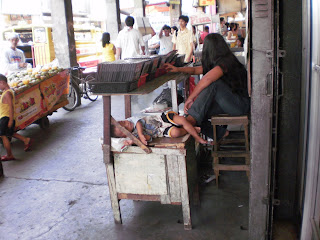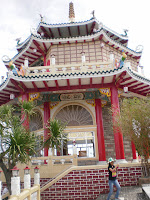Wednesday, September 8, 2010
Woodcarvers in the Philippines
On a recent quiet Saturday (when we had no patients) we were able to go out to Laguna (about a 2 1/2 hour drive from Manila) to visit some of the woodcarvers in their small homes and studios.
These first photos are of Frank and his family. He works in a little area next to his house. Here he is showing us a liahona he has in process. This is a carving of a handcart family he is working on. The large block on the right will become the father figure on the left (pulling the handcart).
This is a carving of a handcart family he is working on. The large block on the right will become the father figure on the left (pulling the handcart).
 Here is a completed handcart family. (On display in one of the offices in the Area Office)
Here is a completed handcart family. (On display in one of the offices in the Area Office)
 This is a statue Frank did of Joseph and Hyrum Smith.
This is a statue Frank did of Joseph and Hyrum Smith.
 From Frank's house we walked down a treelined lane to some of the other woodcarvers' homes. We had a parade of children following us everywhere we went!
From Frank's house we walked down a treelined lane to some of the other woodcarvers' homes. We had a parade of children following us everywhere we went!
 On our walk we passed a group of children under a tree with a vendor selling "colored chicks".
On our walk we passed a group of children under a tree with a vendor selling "colored chicks".
 Our next stop was in the little village of Paete in Laguna. The village has little alleyways lined with homes and shops.
Our next stop was in the little village of Paete in Laguna. The village has little alleyways lined with homes and shops.
 We visited Armand and his family in their home. He carves in a little area of their living room. Armand started carving when he was 12. He now works with his father and uncle.
We visited Armand and his family in their home. He carves in a little area of their living room. Armand started carving when he was 12. He now works with his father and uncle.
 This is Armand and his young family. His wife is due with their third daughter in about 2 weeks (mid-Sept.)
This is Armand and his young family. His wife is due with their third daughter in about 2 weeks (mid-Sept.)
 Here are some of Armand's carvings. He does beautiful nativity sets and
Here are some of Armand's carvings. He does beautiful nativity sets and
reliefs of Mary, Joseph and the baby Jesus.
 This is the nativity he did for us. We have kept it out since he finished it in February. There are 18 pieces in the set.
This is the nativity he did for us. We have kept it out since he finished it in February. There are 18 pieces in the set.
 Note - the wise men have mangoes, bananas and rice!
Note - the wise men have mangoes, bananas and rice!
 We just got this carving. It was done by a cousin of Armand's - showing Filipino children playing a game called "jumping the cow". It reminds us of some of the children we saw on our visit to Laguna.
We just got this carving. It was done by a cousin of Armand's - showing Filipino children playing a game called "jumping the cow". It reminds us of some of the children we saw on our visit to Laguna.
These first photos are of Frank and his family. He works in a little area next to his house. Here he is showing us a liahona he has in process.
 This is a carving of a handcart family he is working on. The large block on the right will become the father figure on the left (pulling the handcart).
This is a carving of a handcart family he is working on. The large block on the right will become the father figure on the left (pulling the handcart). Here is a completed handcart family. (On display in one of the offices in the Area Office)
Here is a completed handcart family. (On display in one of the offices in the Area Office) This is a statue Frank did of Joseph and Hyrum Smith.
This is a statue Frank did of Joseph and Hyrum Smith. From Frank's house we walked down a treelined lane to some of the other woodcarvers' homes. We had a parade of children following us everywhere we went!
From Frank's house we walked down a treelined lane to some of the other woodcarvers' homes. We had a parade of children following us everywhere we went! On our walk we passed a group of children under a tree with a vendor selling "colored chicks".
On our walk we passed a group of children under a tree with a vendor selling "colored chicks". Our next stop was in the little village of Paete in Laguna. The village has little alleyways lined with homes and shops.
Our next stop was in the little village of Paete in Laguna. The village has little alleyways lined with homes and shops. We visited Armand and his family in their home. He carves in a little area of their living room. Armand started carving when he was 12. He now works with his father and uncle.
We visited Armand and his family in their home. He carves in a little area of their living room. Armand started carving when he was 12. He now works with his father and uncle. This is Armand and his young family. His wife is due with their third daughter in about 2 weeks (mid-Sept.)
This is Armand and his young family. His wife is due with their third daughter in about 2 weeks (mid-Sept.) Here are some of Armand's carvings. He does beautiful nativity sets and
Here are some of Armand's carvings. He does beautiful nativity sets andreliefs of Mary, Joseph and the baby Jesus.
 This is the nativity he did for us. We have kept it out since he finished it in February. There are 18 pieces in the set.
This is the nativity he did for us. We have kept it out since he finished it in February. There are 18 pieces in the set. Note - the wise men have mangoes, bananas and rice!
Note - the wise men have mangoes, bananas and rice! We just got this carving. It was done by a cousin of Armand's - showing Filipino children playing a game called "jumping the cow". It reminds us of some of the children we saw on our visit to Laguna.
We just got this carving. It was done by a cousin of Armand's - showing Filipino children playing a game called "jumping the cow". It reminds us of some of the children we saw on our visit to Laguna.Thursday, June 10, 2010
Trip to Cebu (end of May)
The end of May - We were able to go down to Cebu in the Southern Philippines for the open house of the Cebu City Temple. The dedication date is June 13th. It is a beautiful temple right on a main street of Cebu. We spent three days there and did a little touring. Cebu is the oldest "city" in the Philippines - established as a Spanish settlement by Magellan in 1571. {Note: I had too many pictures for one posting so there are three postings of pictures}



Marlon was able to go to Cebu with us.
 Adjacent to the temple is a stake center, a three story building (below right) with temple patron housing, temple missionaries' apartments, Cebu Mission Office, distribution center and waiting area. The homes of the mission president and the temple president are also located on site. (to center back of the photo)
Adjacent to the temple is a stake center, a three story building (below right) with temple patron housing, temple missionaries' apartments, Cebu Mission Office, distribution center and waiting area. The homes of the mission president and the temple president are also located on site. (to center back of the photo)



Marlon was able to go to Cebu with us.
 Adjacent to the temple is a stake center, a three story building (below right) with temple patron housing, temple missionaries' apartments, Cebu Mission Office, distribution center and waiting area. The homes of the mission president and the temple president are also located on site. (to center back of the photo)
Adjacent to the temple is a stake center, a three story building (below right) with temple patron housing, temple missionaries' apartments, Cebu Mission Office, distribution center and waiting area. The homes of the mission president and the temple president are also located on site. (to center back of the photo)Trip to Cebu #2
Here are more pictures from our trip to Cebu City.
This is Fort San Pedro - built by Legaspi when he returned with Spanish reinforcements 40 years after Magellan. The original fort was wood but was replaced quickly with a stone fort.






The original well still has water in the bottom!
 A group of students playing guitars, banduras and a "cello" like a bass guitar.
A group of students playing guitars, banduras and a "cello" like a bass guitar.
Dancer in native costume outside the fort.
I love the shell lights!!
This is Fort San Pedro - built by Legaspi when he returned with Spanish reinforcements 40 years after Magellan. The original fort was wood but was replaced quickly with a stone fort.






The original well still has water in the bottom!
 A group of students playing guitars, banduras and a "cello" like a bass guitar.
A group of students playing guitars, banduras and a "cello" like a bass guitar.Dancer in native costume outside the fort.
I love the shell lights!!
This is the Basicilia of the Santa Nino (baby Jesus). The story is that Magellan brought a statue of Jesus as a child. It was left behind when the Spanish left after Magellans death. When Legaspi returned 40 years later, a tribe had found it and made a special shrine. The tribe was convereted to the Catholic Church and the statue is housed in the Basilica. (built in the 1600's)
Wednesday, June 9, 2010
Trip to Cebu City #3
Here are more pictures from our trip to Cebu
We visited some of the remaining Spanish era houses. This one is from the late 1700's - Made of all wood with very open rooms and open beam ceiling. Notice the harps. There were 3 old European harps in the house.

We visited some of the remaining Spanish era houses. This one is from the late 1700's - Made of all wood with very open rooms and open beam ceiling. Notice the harps. There were 3 old European harps in the house.

This is Casa Gorordo - a well preserved home from the mid 1800's. The house is built with sliding panels so the rooms can be opened up and air can move through to cool the house. There are beautiful carved wood borders at the top of the panels.
The second floor had an open balcony running the entire length of the house.
This is the LapuLapu Monument in honor of King LapuLapu who killed Magellan when he tried to force the King's tribe to convert to the Catholic Church.
Subscribe to:
Posts (Atom)








































